What is Yoga Nidra? Exploring Its Stages and Scientific Benefits
When it comes to yoga, many people think of the typical bends, stretches and meditative poses. When you delve into the true essence of yoga, you will find that yoga is much more than just physical exercises. Yoga is...
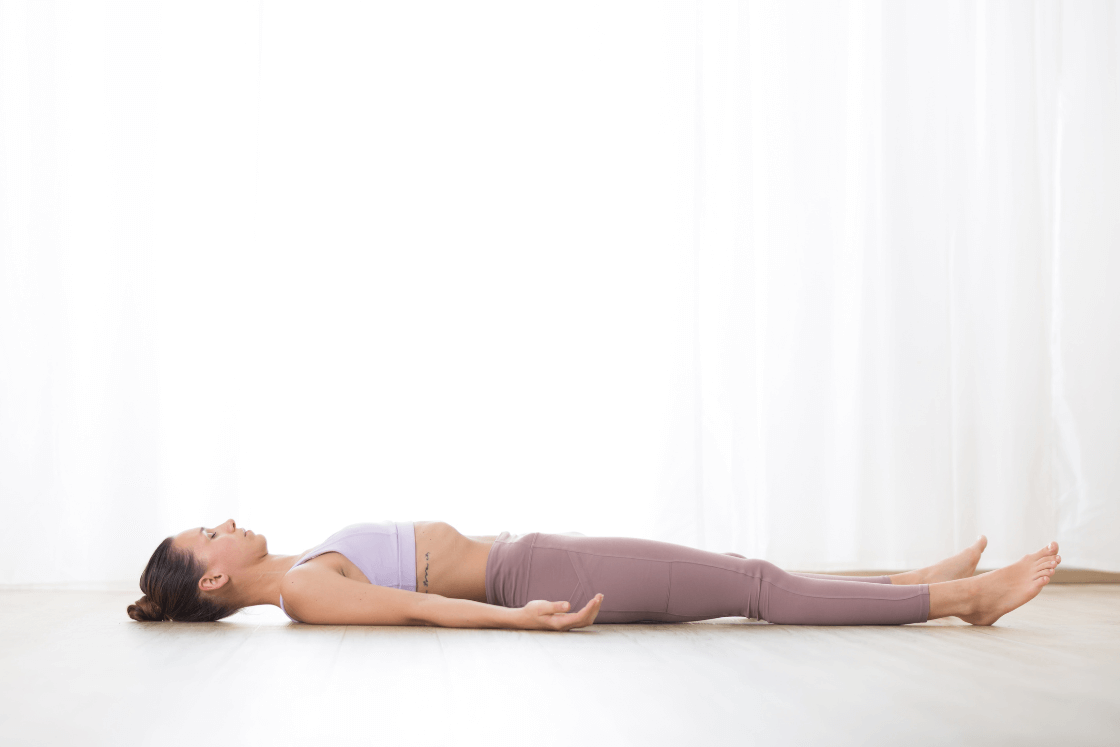
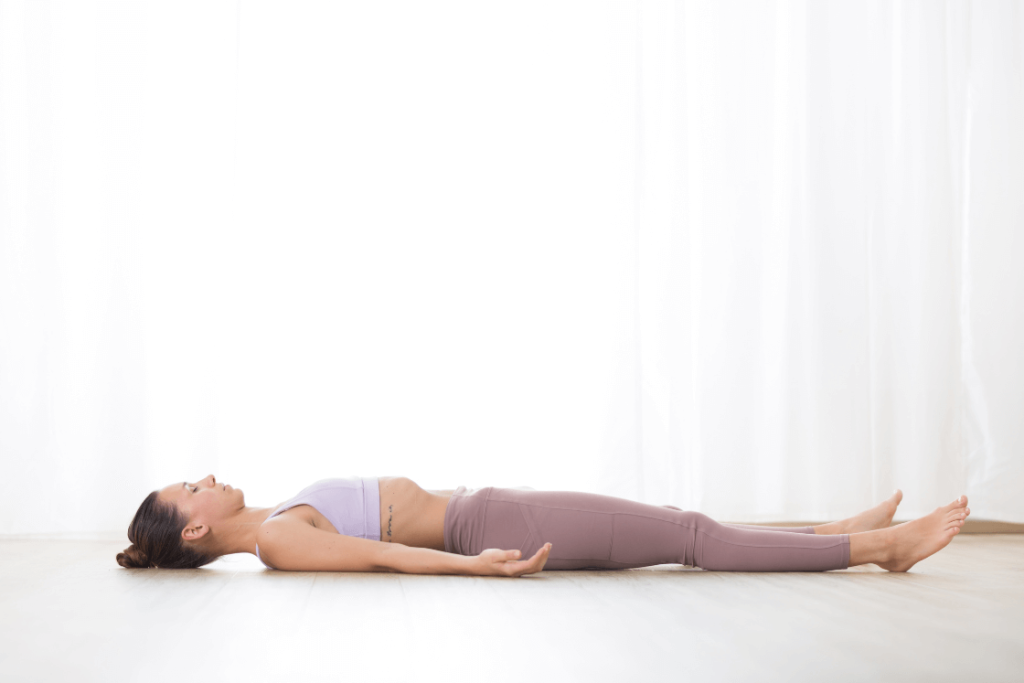
When it comes to yoga, many people think of the typical bends, stretches and meditative poses. When you delve into the true essence of yoga, you will find that yoga is much more than just physical exercises. Yoga is the art of improving our daily activities so that they bring maximum benefit.
In our daily lives, everyone desires a few moments of relaxation. Everyone longs for some rest and sleep. Or do we not?
It is obvious that sleep offers us many physical and mental moments of relaxation. But what if I say that this sleep combined with yoga can help you feel a different state of consciousness that gives you relief from a variety of depression and stress?
Amazed?
Yes, you read that correctly. Yoga involves a sleep technique that takes you to the next level of physical and mental relaxation and relieves stress, anxiety and depression. However, this technique does not require you to twist or stretch your body. Here we will talk about a yoga sleep technique, namely Yoga Nidra.
What is Yoga Nidra
Yoga Nidra, commonly known as yogic sleep, is a practice to experience a state of consciousness between waking and sleeping states. Here, the physical body rests, but the brain wakes up and monitors the physical body. In other words, yoga nidra is mental sleep, sleep with full consciousness.
In this yoga practice, one explores pratyahara (withdrawal of the senses), the fifth limb of Ashtanga yoga. Here one turns all four senses inward, listening with the ears for instructions. Yoga Nidra also includes Pranayama (yogic breathing) and Dharana (concentration).
According to Swami Satyananda, one hour of yoga nidra is equivalent to four hours of normal sleep. In other words, after half an hour of Yoga Nidra you will feel as relaxed as after two hours of deep sleep. The main goal of Yoga Nidra is to deepen relaxation and increase inner awareness and consciousness.
Origin & History of Yoga Nidra
Yoga Nidra was first mentioned in Upnideshas. Moreover, its origin can be seen from the ancient Tantrik text called Nyasa. In modern times, it was developed and arranged by Satyananda Saraswati (who experienced it with his guru Shivananda Saraswati) in the 1960s. Hence, it is also mentioned in Mahabharata.
‘The Ocean is the bed of the lotus-navel Vishnu when at the termination of every Yuga that deity of immeasurable power enjoys Yoga-Nidra, the deep sleep under the spell of spiritual meditation.’ — Mahabharata, Book 1, section XXI
In ancient times, Sages practice Yoga Nidra in the path of liberation (Moksha) to get aware of their Samskaras and purify them.
Stages Of Yoga Nidra
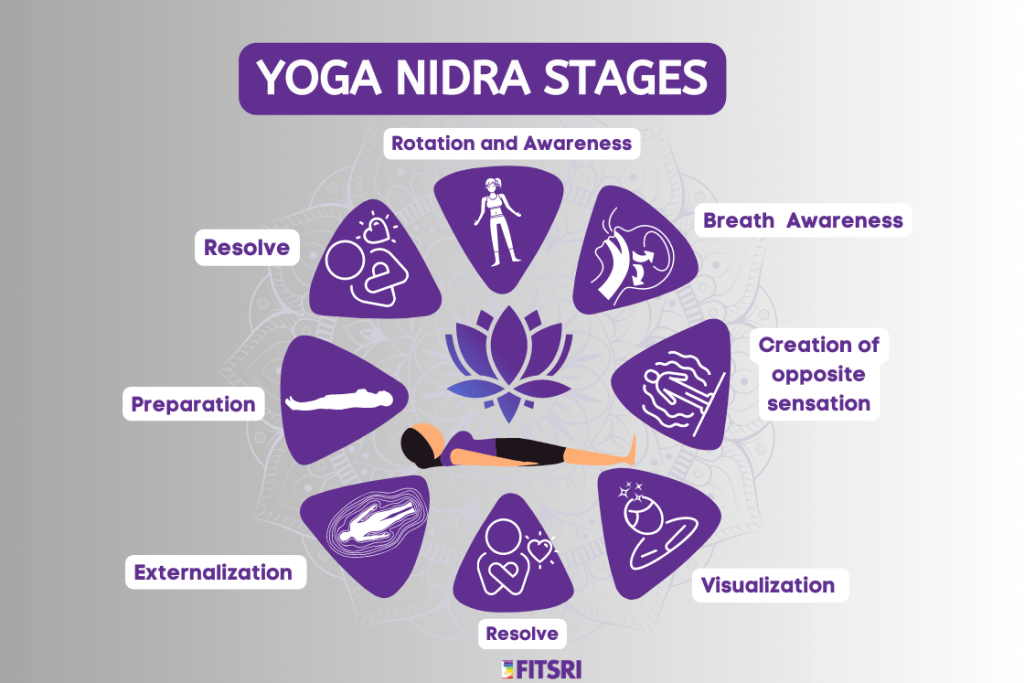 fitsri.com
fitsri.comThere are typically 8 stages a practitioner goes through when practicing yoga nidra. These stages are:
Preparation
The steps mentioned above form a basic part of preparation. This step is important as it encourages you to relax completely and prepare your mind and body for the session.
Resolve/Sankalpa: Setting Positive Affirmation
Here resolve means sankalpa or resolution or intention. When you enter the subconscious mind, you want to plant a “positive seed of resolve”. The resolve is like a positive affirmation that you repeat during yoga nidra. This simple phrase has the power to move your life in a positive direction.
It can refer to what you need in the current situation of your life, or to something you desire in the long term.
Examples of simple and positive resolutions can be, “I am happy and relaxed”,” “I am positive”,” “I am confident”,” “I am forgiving”,” “I am mindful and aware,” “I am spiritual”,” or “I am worthy”.”
These short statements have enough power to shape your thoughts and feelings to make you feel positive, healed, and rejuvenated in your daily life.
Remember that your resolution should not contain negative words such as “no”, “do not”, “never”, etc., as your subconscious mind tends to ignore such words. For example, if your resolution is “I will not drink alcohol”,” your subconscious mind will not register the word “do not.” This makes your affirmation redundant since your subconscious now seems to understand that you want to drink alcohol.
Whatever resolution you make, it should be short, precise, and simple, but positive.
Another important point is that this resolution should be maintained over a long period for it to be effective and have an impact on your psyche. However, if you can not make a resolve, don’t worry. Take your time to make your decision.
You will be asked to mentally repeat the resolution 3 times.
Rotation and Awareness of Body Parts
In this phase, the teacher will name a part of the body to which you must direct the attention of your awareness or consciousness. This is only the movement of the mental awareness, not the physical movement of the said body part.
In this way, you relax your brain activity by calming the sensory-motor cortex. It is extremely effective in releasing tension throughout the body as you gradually bring the body into awareness. So be sure to pay attention to the teacher’s instructions.
Breath Awareness
Once you are done with the rotation of consciousness, turn your attention to your breathing.
As you continue to breathe at your natural pace during this phase, your attention will be drawn to the gentle rising and falling of your abdomen, chest, and sometimes even neck.
You may also be asked to count the movements in your mind. There is a high chance that you will feel sleepy, which is natural. If this is the case and you lose track of counting, simply start over.
This will relax you even more and allow the prana to flow freely through the body.
Creation of Opposite Sensation
During this unique phase of Yoga Nidra, you have the opportunity to explore opposing sensations without judgment. It involves experiencing sensations such as heaviness and lightness, hot and cold, which allows you to activate different parts of the brain and switch between the right and left hemispheres.
By consciously creating these extreme sensations and stimulating the brain, you promote a state of balance and homeostasis. This process also helps to build new neural pathways as you experience unfamiliar sensory experiences.
Engaging in contrasting feelings and emotions can strengthen willpower, promote emotional balance, and cultivate a sense of mental calm. Yoga Nidra practice provides a valuable opportunity for personal growth and self-discovery.
Visualization : Guided Imagery Experience
Visualization is an important part of Yoga Nidra, as it promotes self-awareness and reduces mental stress. In this phase, sometimes called Rapid Objects Visualization, the teacher quickly names various images for you to visualize behind your closed eyes.
These images often consist of familiar everyday objects, people, or scenes, such as a tree, the sky, a sunset, the moon, a traffic light, a friend, or your room. You may also be asked to imagine a flowing river, a beautiful painting, your favorite flower, or majestic mountains.
Visualizing these elements leads to a sense of inner peace and tranquility, creating a receptive state of mind into which positive thoughts can effortlessly enter. It enhances the overall relaxation experience of Yoga Nidra and allows for a deeper connection with yourself.
Resolve/Sankalpa
When the yoga nidra practice comes to an end, you will be asked again to repeat the resolution you made at the beginning of the practice. Since your mind has become receptive, it is a good time to evoke the positivity of the resolution and let it sink deep into the subconscious.
Just as at the beginning, mentally repeat the resolution three times.
Externalization
Just as you slowly and gently entered the deep state of Yoga Nidra, it is important to maintain the same pace and rhythm to come out of the trance-like state.
The yoga instructor will guide you to gradually come out of yoga nidra by bringing your attention back to your breathing and body, asking you to move your limbs, and slowly becoming aware of the sounds of the environment.
If you are unable to come out of Yoga Nidra, you can take your time during this phase to avoid any disorientation or confusion.
How to Perform Yoga Nidra
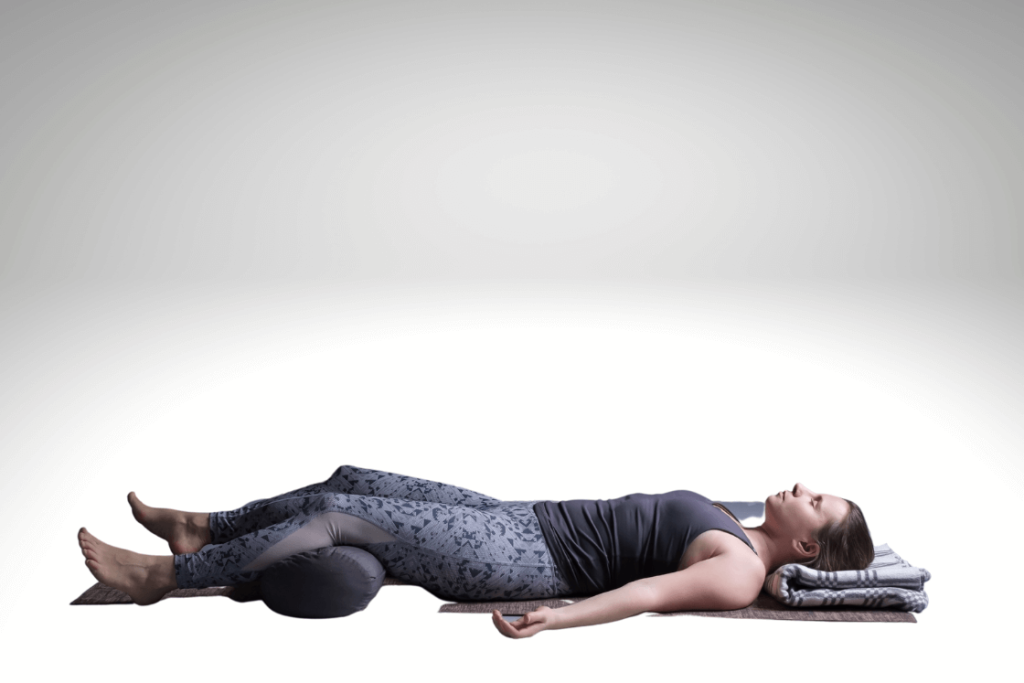
Yoga Nidra is among the simplest Yoga practices. Above all, you don’t need to sit in a Yoga Asana or do any typical stretching. You just need to lay down on your back and relax.
Before rolling out your yoga mats, gather all the instructions about Yoga Nidra. It is better to have audio instructions whether from a teacher or an audio device. Make sure the voice to be clear, soft and soothing.
Steps by Steps Guide Yoga Nidra
Before going directly to the main course, you need to prepare yourself and the atmosphere for the Yoga Nidra. For this, you should go through the following steps.
Prepare a soft foam or yoga mat and a blanket with a soft pillow. Ley it on the floor. Prepare the atmosphere with incense sticks and candles. Make sure to keep them in lite amount. Excessive incenses and candles can ruin your practice. Wear loose clothes, to get comfortable with breathing and concentration. Make the room calm and silent. Perform some warm-up exercises such as Sun salutation (Surya Namaskar).After doing all these arrangements, it is time to move towards the Yoga Nidra.
Lie down flat, over the mat or foam, on your back. Keep a pillow under your head for better comfort. Stretch out your arms, as well as feet, out a little for your comfort. Cover yourself with a blanket, only if you are comfortable. Remember to keep yourself cozy. Chose a clear intention or Sankalpa. Then, close your eyes smoothly and take a couple of deep breaths. This will redirect the flow of prana to your Chitta. Now, repeat the intention/Sankalpa a few times. Now, start by bringing your awareness to the right foot for a couple of seconds, and relax it at the same time. Similarly, rotate your awareness throughout the whole body. Visualize your whole body and its aura. Visualize yourself floating. Hold this process as long as you can. Ones you are done, bring your consciousness back to ordinary, take some deep breaths and slowly open your eyes.You will better understand the steps by going through the stages of Yoga Nidra.
Yoga Nidra Precautions
Like every other yoga practice, Yoga Nidra also has some precautions that you need to take for the best results. These are the following.
Do not perform immediately after a meal. This practice includes relaxation, so doing it after taking mean can make sluggish and you become much prone to fall asleep. Even a little unnecessary noise can distract you in Yoga Nidra. Therefore, make sure to practice it in a quiet place.How Yoga Nidra is Different From Meditation
Yoga Nidra and meditation might look similar but they are not the same. They are quite different from each other.
During meditation, you usually sit and keep your spine straight. You bring your awareness to your breath and stay aware and alert. You keep your body in an asana and they start focusing on your inner self.
On the other hand, in Yoga Nidra, you simply lie on the floor, bringing your awareness inwards, and move into, a hypnagogic state, between awake and asleep state. Here your body relaxes freely and does not do any work except breathing.
In meditation, the main aim is to establish a connection with the inner self. It uses one-pointed concentration, sometimes done by gazing a candle or flame, sometimes by concentrating on an object in the mind. It is training the mind on a particular point.
While in Yoga Nidra, the main aim is the systematic relaxation of the body. It uses the mind to direct awareness of all senses of the body inwards. Here our physical body remains in sleep but the mind remains lucid.
How Does Yoga Nidra Work
What happens in Yoga Nidra
Here, the same thing happens as with normal sleep, but in a controlled manner. When you start falling asleep, the brainwaves start from the active waves, beta waves (12-35Hz) and shift to relaxed waves, alpha waves (8-12Hz). Then they join the lowest frequency waves, delta waves (0.5-3Hz). Then, through the practice of Yoga Nidra, you acquire the “hypnagogic state (being awake and sleeping)” the door between alpha and theta waves (3-8Hz). Here Your body is relaxed but your mind is still working. This practice holds us in this state and does not let us go beyond this stage. If someone goes ahead of this stage, he/she falls asleep.
You might have noticed that our mind is always full of thoughts. Consequently, there are thousands of thoughts roaming in our mind every minute. Yoga Nidra simply decreases the number of thoughts in our mind for a certain period. As a result, this brings a deep sense of awareness and relaxation.
Yoga Nidra is defined as dynamic sleep that includes the incorporation of alfa and delta brainwaves. Through its practice, your brain acquires a modified state of consciousness, easily.
Our sleep depends upon the brainwaves. There are 5 brainwaves that regulate our sleep. These are
Gamma Waves (35Hz>) Beta Waves (12-35Hz) Alpha Waves (8-12Hz) Theta Waves (3-8Hz) Delta Waves (0.5-3Hz)What Happens in Normal Sleep
Normally, our brain waves are Beta Waves (12-35Hz), when we are awake. When you try to sleep, brainwaves shift from high-frequency Beta waves (12-35) to low frequent Alpha waves (8-12Hz). Here you start sleeping. Then the brainwaves move to Theta Waves (3-8Hz). Here thoughts become less frequent and we get closer to deep dreaming. After some time, we shift to Delta Waves (0.5-3Hz). Here you are in a deep sleep. Consequently, you are less likely to get affected by surrounding and it is very hard to wake you now.
Yoga Nidra Scientific Benefits
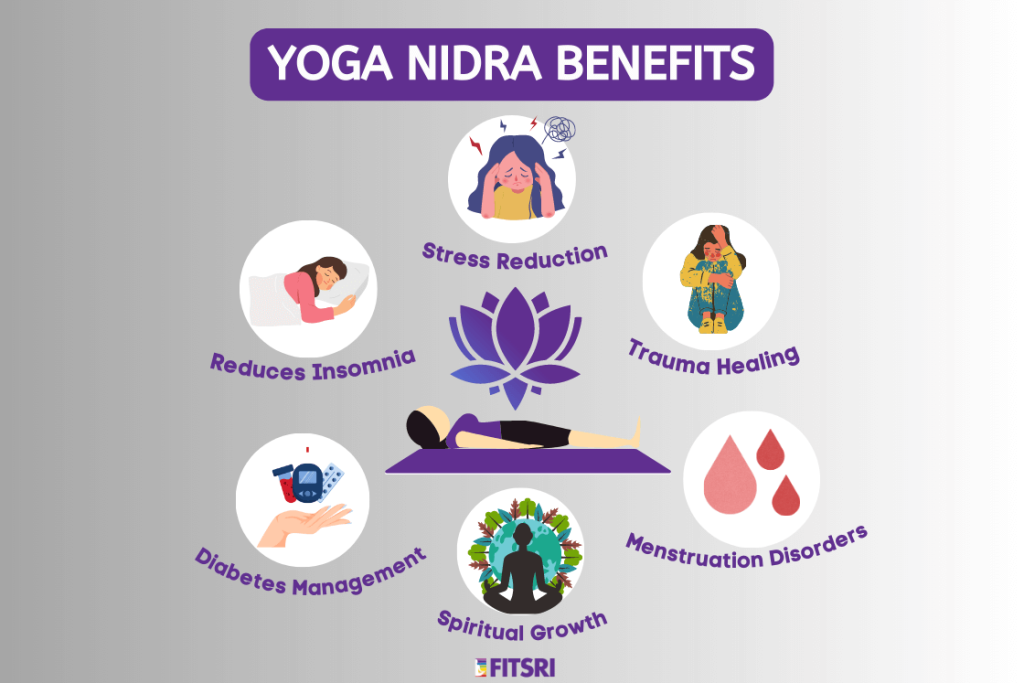
However, Yoga Nidra is not very hard to perform, still, it comes with various health benefits. Here are some benefits of Yoga Nidra.
Reduces Insomnia
As Yoga Nidra is a deep relaxation practice, it relaxes all the muscles of the body and brain. When the body is relaxed, it is not very hard to fall asleep. Thus it helps to reduce insomnia (trouble in falling and/or staying asleep) and helps you to fall asleep.
In 2017, a study was published in which researchers examined the effects on two elderly volunteers who suffered from sleep problems. After a 4-week yoga nidra intervention, both volunteers experienced a significant improvement in sleep quality that persisted after 3 months.
This is also the reason why Yoga Nidra is often recommended before bedtime to promote sleep.
Helps to Treat Diabetes
Diabetes is basically a metabolic disorder, that is common nowadays, due to a lack of physical activity. With the practice of Yoga Nidra, the blood glucose level, which is a major factor of diabetes, decreases gradually. Therefore is preferred to perform this practice in conjunction with the medication.
Reduces Anxiety and Stress
In our busy lives, we merely get time to calm and relax our minds. This causes a lot of stress and anxiety in our life.
Yoga Nidra relaxes and calms the mind. To calm the mind, Yoga Nidra gradually reduces unnecessary thoughts, which causes anxiety and stress.
A study on college professors found that Yoga Nidra is an effective tool in reducing both cognitive and physiological symptoms of anxiety.
Another research on students states Yoga Nidra has a favorable effect on life stress and self-esteem in students. It decreases stress and increases self-esteem gradually.
Thus, Yoga Nidra is very helpful in reducing stress and anxiety, improving mental health and wellness.
Reduces Problems Related to Menstruation Disorders
Menstruation disorders are common among women. In this phase, they face many psychological problems such as anxiety, anger, stress, and depression.
Yoga Nidra soothes the mind nerves and balances the hormonal disbalance in the body, which helps in reducing the problems associated with menstrual disorders. It is best to practice this yoga practice in conjunction with the medication. Research says Yoga Nidra is a strong remedy to rectify the problems associated with menstrual disorders.
Helps to Improve the Qualities of an Adolescent (Growing Kid)
Yoga Nidra increases self-awareness and self-esteem. This fills an adolescent with a feeling of happiness, positivity, and enthusiasm. It results in the overall well-being of a growing kid.
A study shows, Yoga-Nidra is very helpful in developing various aspects of adolescent well-being.
Helps to Reduce the Effects of Trauma
Many of us had experienced Trauma (psychological and emotional response to a deeply disturbing event), especially in the military. These experiences leave an ill effect on our mind, that lasts for a long time (sometimes forever). Yoga Nidra soothes the thought process, relaxes the mental sensation, and calms the mind constantly. This helps to reduce the effects of trauma.
Research on military combat veterans found that Yoga Nidra practice reduced anger, anxiety, and emotional reactivity. Moreover, it relaxation, stillness, self-awareness, and self-efficacy.
Another study on Women with sexual Trauma states, Yoga Nidra decreases the post-traumatic stress disorders and body tensions. Besides, it improves sleep, the ability to handle intrusive thoughts and stresses.
Improves Heart Rate Variability
Low Heart Rate Variability increases the risk of cardiovascular disorders and death, therefore it is important to maintain high Heart Rate Variability.
When you are in a very anxious state the Heart Rate Variability reduces. While Heart Rate Variability increases as you move to a relaxed state. Yoga Nidra helps you to relax and thus, helps to increase Heart Rate Variability.
A study states that Yoga Nidra produces favorable changes in measures of Heart Rate Variability
Conclusion
Through a process of profound physical, emotional, and mental relaxation, the yoga nidra technique helps prevent stress and its associated conditions. When done carefully and intentionally, this guided meditation is incredibly therapeutic.
Yoga Nidra can be therapeutic if you have a mental health issue, suffer from chronic pain, or simply want to improve your overall health and well-being.
With a daily yoga nidra practice, you can improve, adjust, or direct your routines and lifestyle towards a greater sense of well-being. It is possible to achieve a high level of calm in a short period if you practice with dedication and awareness.

 MikeTyes
MikeTyes 


































